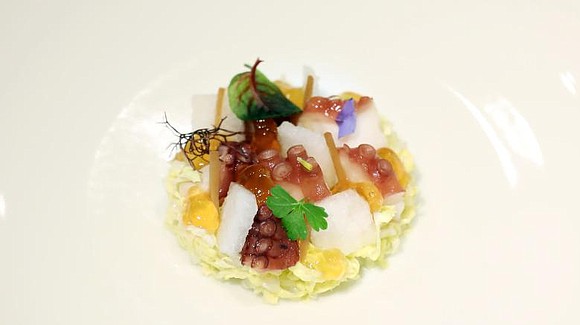Noodle diplomacy: What do leaders eat after making history?
CNN/Stylemagazine.com Newswire | 4/24/2018, 7:20 a.m.
By Joshua Berlinger, Stella Ko and Jungeun Kim, CNN
(CNN) -- Pyongyang's cold noodles are the most famous on the Korean peninsula. They're so good, that the North is dispatching its top chef to the border, along with a noodle-making machine, to recreate it for dinner after Friday's historic inter-Korea summit.
South Korean President Moon Jae-in's administration announced Tuesday what would be on the menu when they join North Korean leader Kim Jong Un for dinner after the two meet for the first time Friday.
Moon's office released the menu along with detailed descriptions of each course, its source and inspiration. Nearly every dish has an extra dash of symbolism.
Guests will be served a dish from the hometown of the three South Korean presidents who have hosted or will host an inter-Korean summit. They'll eat food from the Korean peninsula's far north and south. There'll even be food sourced from the demilitarized zone that divides the two countries.
Here's a snippet of what they'll enjoy.
Pyongyang Naengmyun
Pyongyang Naengmyun is a dish of cold noodles beloved by many Koreans but perfected by the North Koreans. Kim Jong Un has agreed to bring the head cook from Okryugwan, a restaurant in the North Korean capital famous for the Naengmyun, to the summit to prepare the dish as a gesture of good will. A noodle-making machine will be installed so the diners get to enjoy freshly-made noodles.
Cold octopus salad
The octopus for this dish will come from the seaside town of Tongyeong, the home of the late classical musician and composer Yoon Yi-sang. Yoon was a prominent democracy activist during South Korea's periods of dictatorship.
Korean-style Swiss potato rosti
This appetizer is a Korean twist on a Swiss classic. It is meant as a nod to Kim Jong Un's younger days, when he studied abroad in Switzerland.
Pyeonsu
They'll also enjoy a dumpling course called Pyeonsu, with croaker and sea cucumber. The chefs will source the filling from Gageodo, former President Kim Dae-jung's hometown. Kim's administration organized the first in-person meeting between the leaders of North and South Korea in 2000.
Roast Dalgogi
Another seafood dish, this time a famous local food from the southern South Korean city of Busan, where Moon Jae-in spent his childhood.
Barbecued beef
The beef they'll enjoy hails from Seosan ranch in South Korea's western Chungnam province. The ranch is famous because it's where the founder of one of South Korea's most successful corporations, Hyundai, keeps his herds of cattle.
In the 1990s, the Hyundai founder drove hundreds of his cows across the demilitarized zone into North Korea as a donation to Pyongyang.
But Hyundai also has a tainted history when it comes to inter-Korean summits. The company was believed to have been used as a conduit to pay North Korea hundreds of millions of dollars just days before the 2000 summit between Kim Jong Il and Kim Dae-jung, polluting the latter's legacy.
Bibimbap They'll enjoy bibimbap, a Korean dish with rice, vegetables and eggs served in a bowl. The rice for the dish will be from the Bongha village in Gimhae Province, the hometown of Roh Moo-hyun, who traveled to Pyongyang for the 2007 inter-Korean summit.
The greens will come from the demilitarized zone.
Steamed red snapper and catfish
Catfish is commonly eaten throughout the Korean peninsula during feasts, so its inclusion is meant to symbolize the similarities between the two countries, the South Koreans said.
Snapper is a freshwater fish found throughout both Koreas.
Mango mousse
The tropical fruit is being included here as a symbol of the energy of spring, according to the South Korean government.
Tea and rice cake
The other dessert on the menu has two parts. The pine mushroom tea is from the Baekdudaegan Mountains in the far north of North Korea, while the Hallabong cake is from the island of Jeju in one of the most southern parts of South Korea.
Beyond distance, each point also has its own symbolism.
The Baekdudaegan range originates from Mount Paektu, the spiritual home of the Korean people and the supposed birthplace of the founder of the first Korean kingdom.
Jeju was long a home for democracy activists and opponents of the South Korean military dictators and the Japanese occupation before them.
Today it's known as "Peace Island."




